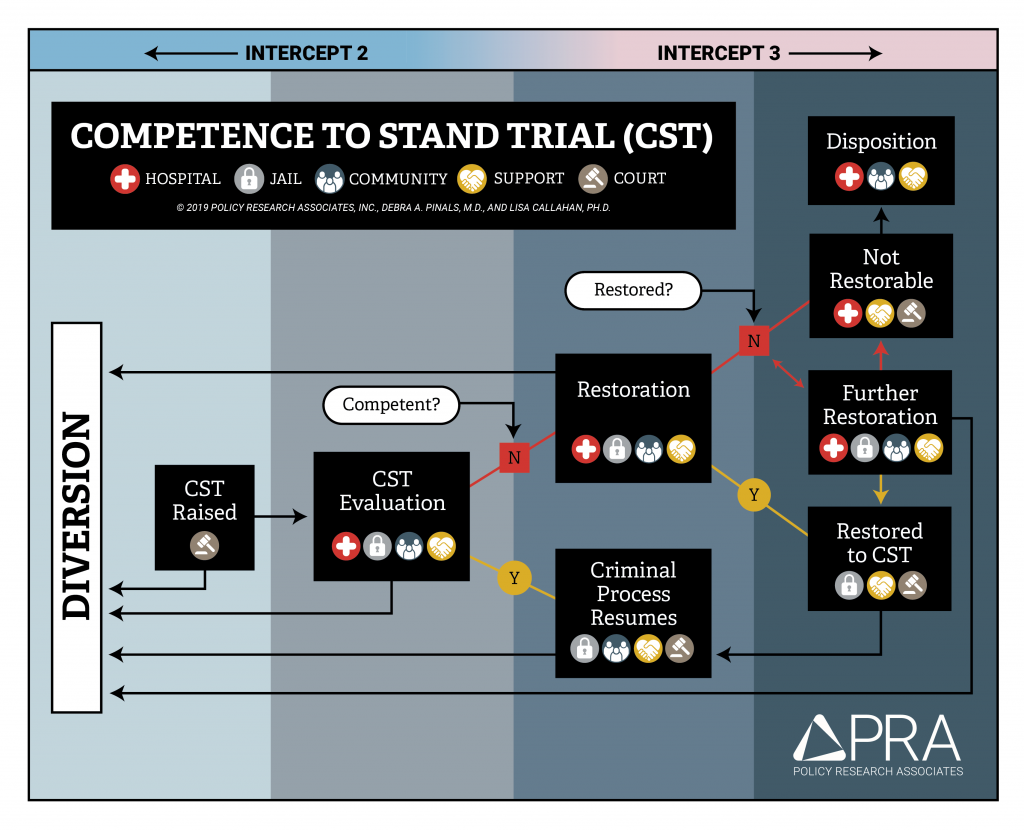The Sequential Intercept Model (SIM) provides a framework for identifying decision points and opportunities to divert individuals with behavioral health conditions out of the criminal justice system and into community-based treatment and supports.[1],[2] For some defendants, the trial process is put on hold if they exhibit signs or symptoms of conditions that can impair their ability to competently proceed. When a defendant’s competence to stand trial (CST)[3] is raised, usually these defendants are routed through forensic evaluations and systems. They are rarely considered for diversion, despite having serious mental illness (SMI), intellectual and developmental disabilities (IDD), or other conditions that can affect their thinking and courtroom behavior. The CST flowchart below identifies decision points in the CST process where justice and behavioral health professionals can consider and create diversion opportunities for these defendants.
CST is typically raised in Intercepts 2 (Initial Detention and Initial Court Hearings) and 3 (Jails and Courts), after arraignment and before case adjudication and sentencing. These two intercepts include a wide range of options to divert individuals for whom CST is raised, who have been adjudicated incompetent to stand trial (IST) with the potential for restoration, or even for those adjudicated not restorable. Possible interventions include conducting rapid evaluations and training evaluators to explore and describe community-based services for the court’s consideration. For defendants found IST, community restoration can be an alternative to hospital-based restoration. Possible strategies at Intercepts 2 and 3 include competence dockets, specialized probation, and ongoing risk-assessment and level-of-care determinations. Not all defendants in the population need the same level of care or detention in jail, and many can be safely and effectively supported in the community.
Strategies for early diversion of persons for whom CST will likely be raised at Intercepts 0 and 1 include law enforcement efforts at de-escalation, deflection, and pre- and post-booking diversion. Collaborations across law enforcement, emergency departments, and crisis services can assist practitioners in identifying alternative pathways for individuals with SMI, IDD, and other conditions to avoid a criminal justice response. Avoiding deeper criminal justice involvement guides diversion.
Defendants being evaluated for CST or found IST are pre-trial, yet few defendants who are awaiting CST services, either evaluation or restoration, are released on bail, even when charges are minor. Defendants restored to competence may be sentenced to jail or prison. Re-entry planning can include assuring community treatment supports are in place for maintenance of restoration, such as specialized case management and consistent medication. “Re-entry” planning can be extended to include such supports when such individuals are discharged to jail from state hospitals. For defendants who are adjudicated unrestorable, dismissal of charges can be coupled with linkages to treatment and even some rational oversight when the clinical need and public safety risks are high.
Notes
[1] Dan Abreu, Travis W. Parker, Chanson D. Noether, Henry J. Steadman, and Brian Case. “Revising the Paradigm for Jail Diversion for People with Mental and Substance Use Disorders: Intercept 0.” Behavioral Sciences & the Law 35, no. 5–6 (September 2017): 380–95. https://doi.org/10.1002/bsl.2300.
[2] Munetz, Mark R., and Patricia A. Griffin. “Use of the Sequential Intercept Model as an Approach to Decriminalization of People With Serious Mental Illness.” Psychiatric Services 57, no. 4 (April 2006): 544–49. https://doi.org/10.1176/ps.2006.57.4.544.
[3] In some jurisdictions, the term fitness to proceed, adjudicative competence, or other terms signify the same issue.


